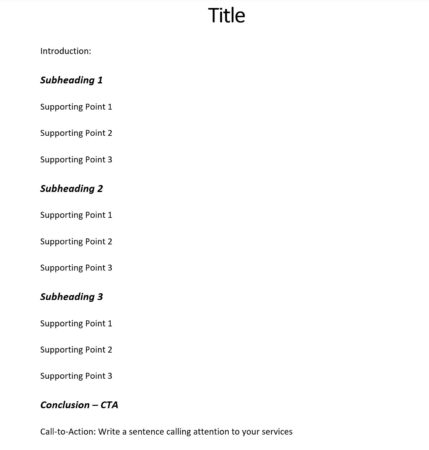Are you a fitness business owner who wants to start a fitness blog?
Or maybe you’re a trainer who wants to write (and sell) an e-book or training guide to share your knowledge with the world.
Writing a fitness blog or e-book is a great way to demonstrate your authority, provide value to readers, and potentially make passive income.
In turn, these readers are more likely to do business with you, even if all you’re doing is selling products through affiliate links.
Now, with all that said, fitness writing can be tough if you’ve never put the digital pen to the pad.
If you’re finding it difficult to put your thoughts and expertise into words, I’m going to discuss 9 simple ways that will help you become a better fitness writer.
1. Write What You Know
This part will probably be the easiest part of this whole process (maybe).
If you’re a fitness business owner, what do you sell?
Are you a personal trainer? What’s your specialty?
If you’re someone who isn’t in the industry and you want to discuss something related to fitness, what is that thing?
Do you want to review fitness products like equipment or supplements?
I can go on and on with these questions, but it comes down to one principle:
Write about what you know.
If you have an expertise in one area of fitness, I’d recommend sticking to that.
For example, let’s say that your niche is bodybuilding. You’ve worked with men and women, helping them prepare for bodybuilding competitions.
Instead of having a collection of generic health and fitness blog posts about muscle building, dive deep into the topic of bodybuilding.
Go further than every other blogger out there. If that’s your expertise, you should be able to talk about bodybuilding in depth for dozens (if not hundreds) of posts.
2. Practice Writing (Especially When You Don’t Feel Like It)
To become a better fitness writer, you need to write.
And if you’re serious about being a fitness copywriter, that means you’ll do it everyday.
Yes, there will be days that you don’t want to bother with it, but those are the days you typically grow the most as a writer.
You push past that internal resistance and produce something.
The more you write, the easier it becomes to write (and the better your writing will be).
Practicing writing is also how you’ll find your voice.
Don’t let this worry you. Every writer goes through their own process with finding their voice.
Sometimes you’ll hear that you should write how you talk.
I don’t agree with this completely, but there’s truth to this.
You wouldn’t include the “uhs” and “hmms” of normal conversation, but it’s the focus on a casual style that’s important.
You want the blog post to feel like a well-edited conversation with your friend.
Most writers start by emulating a writer they love. But with practice, all writers will stumble across their voice and style.
You can’t do that without practice.
3. Start with the Outline
As a writer, it’s tempting to dive right into the first draft and get the thing over with, but I wouldn’t recommend that.
You need to start with the outline.
Think of an outline like the skeletal structure of the body of the post.
You are building the literal foundation of what is to come, and you better make sure all the pieces are in the right place.
What would have happened if Frankenstein put the monster’s arms where its legs should be.
That would completely change the story we all know (in a strangely comical way).
A basic blog outline looks like this:

You can include more subheadings, but this should give you a general idea of how to set things up.
When you’re writing your outline, try to boil down the supporting points into their most basic forms. This shouldn’t take any more than one sentence.
4. Don’t Overthink the First Draft
Your first draft is probably going to be terrible. There’s no way around it.
But that’s okay!
The important part is that you put something down on paper (or screen).
It doesn’t have to be (nor should it be) perfect, especially on the first time around.
That’s what revisions are for.
Still, I guarantee that most of you are going to have that brain meltdown moment. You’re going to second guess yourself on everything. And you might even turn off the laptop in frustration.
And again, that’s okay. It’s a start.
Next time you step up to the pen or computer screen, take a few deep breaths, and just let yourself write.
Don’t worry about spelling mistakes or accurate information.
Don’t focus on run-on sentences or if something sounds “right.”
Just write.
There’s a reason writers invented the editing process. And that’s the next step.

5. Engage Your Readers
People have short attention spans.
Especially when it comes to the written word (we’re all guilty of it).
So, that means you need to do things to your blog post that will engage your readers.
Attention-grabbing titles and headlines are a good start.
You also want to appeal to the other senses.
Include different forms of media such as video, images, and infographics.
You can plan exactly where this media content will go during the formatting of the blog post, but in the meantime, consider what types of content you’d like to use.
6. Get to the Point
First draft is finished and now it’s time to cut the post to ribbons.
As you’re revising that first draft, keep this in mind:
People want information and they want it fast.
You can probably talk for hours about the time you’ve spent in your little bubble of the fitness industry.
But blog readers don’t have that kinda time or energy.
Why take five sentences to convey what you could have said in one?
Expect to cut at least 20% of your first draft.
One of the best tests you can do is this: Focus on the second sentence in a paragraph. Look at the sentence just before it.
If you were to take out that sentence, does the second sentence still make sense on its own? If so, cut the first sentence.

7. Stay on Track
Follow Hemingway’s advice. “All you have to do is write one true sentence.”
That one true sentence better be preceded and followed by another true sentence. True to the main topic.
New writers tend to have monkey brain, swinging from topic to topic.
This is especially true when you’re passionate about what you do, and you can talk about it all day.
If you smash several topics in one post, you’re going to confuse then lose your reader.
Pick ONE topic and stick to it.
This goes for paragraphs too. Each paragraph – each batch of text under a subheading – should be focused on ONE thing.
8. Proofread (Or Pay Someone to Do It)
You’ve gone through a couple of drafts, and you feel confident in what you have in front of you.
Now, it’s time to proofread.
The revision process tends to focus on the content. Proofreading is going to focus more on grammar, sentence structure, and making sure things sound right.
This is when I’d recommend getting a different pair of eyes on your work.
You’ve been staring at the draft for hours and you’re probably sick of reading the same thing over and over again.
This actually makes you more likely to miss grammatical mistakes.
Ask a writer-savvy friend to give it a read, or you can pay a pro to do it.
A quick Google search looking for fitness writers should do the trick, or you can check freelancer websites like UpWork or Fivver.
9. Read to Write
My final tip for becoming a better fitness writer is to read.
Not just fitness blogs, but all types of writing.
You’ll get a sense for what works and what doesn’t.
When you do read the same content you’re creating, you’ll begin to see how other writers hook the reader in the opening paragraph and keep them engaged until the very end.
And if you read a book on writing, you’ll be able to put what you learned into practice immediately.
You’re also guaranteed to stumble upon ideas that’ll help you write more engaging posts.
The more you read, the more you’ll learn how to write in a way that’s interesting, engaging, and informative.
Have Questions About Fitness Writing?
Have you started your journey as a fitness writer yet? If so, what questions do you have?
If you’ve been writing for a while, what’s one piece of advice that you can share with others?

